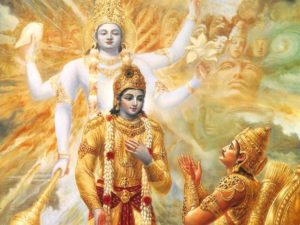 The auspicious occasion of Gita Jayanti will be observed on December 10, 2016 to commemorate the anniversary of the writing of the Hindu scriptural text, Shrimad Bhagavad Gita. This text, more popularly referred to as ‘Gita’, was compiled by Sage Ved Vyaas over five thousand years ago on Mokshadaa Ekaadasi in the month of Maarghsheersh(November-December).
The auspicious occasion of Gita Jayanti will be observed on December 10, 2016 to commemorate the anniversary of the writing of the Hindu scriptural text, Shrimad Bhagavad Gita. This text, more popularly referred to as ‘Gita’, was compiled by Sage Ved Vyaas over five thousand years ago on Mokshadaa Ekaadasi in the month of Maarghsheersh(November-December).
Shrimad Bhagavad Gita literally means ‘divine song of God’ and is an extract of one of the world’s longest epics, the Mahaabhaarat. It can be found in the Bhishma Parva of this epic and details the conversation between Bhagavan Krishna and the Paandav prince, Arjuna on the battle field of Kurukshetra at the commencement of the war between the Paandavas and the Kauravas.
Beholding the warriors of the Paandav and Kaurav armies arrayed for battle, Arjuna became faint-hearted and refused to fight. Bhagavan Krishna, his charioteer, delivered potent teachings, convincing him that it was his duty to defend his army and that he ought to stand up and fight. Sanjay, through divine vision conferred upon him by Ved Vyaas, described to the blind king, Dhritarastra, all that was taking place. This dialogue between the Lord and Arjuna, as narrated by Sanjay, comprises the Gita.
This divine discourse, written in Sanskrit, comprises eighteen chapters and seven hundred shlokas (verses) and contains words directly emanating from the lips of Bhagavan Krishna. Many profound truths have been revealed in this text. The practices leading to self-realization, Bhakti (devotion), Karma (action) and Gyaan (knowledge) Yoga have been explained by Him at great length.
One of the practices that has been emphasised throughout the text is the necessity of performing one’s duty. This is borne out quite clearly as the first two words of first chapter are: “Dharmakshetre kurukshetre”-the field of activity is the field of one’s duty. Later in Chapter Three, Bhagavan informs that whoever does not do his duty is sinful, while the individual who performs his actions without attachment attains the Supreme.
Some other subjects discussed in depth are: the nature of the soul, the sattvic(pious),rajasic (materialistic) and tamasic (sluggish) characteristics, the importance of selfless action, devotion to the form and formless God, the different forms of sacrifices ,to name a few.
There is no doubt that this text is a mine of mysteries, an in-depth study of which can lead to a revelation of some of the most sublime truths and a clearer understanding of the all-pervasive God. On this auspicious occasion of Gita Jayanti, a suggested resolve to strengthen the practice of Rishi Yagya is to engage in the daily study of the Gita. Chapter 18, verse 70 of this text states “Whosoever studies this sacred dialogue of ours in the form of the Gita, by him too shall I be worshipped through wisdom-sacrifice; such is My mind.”


